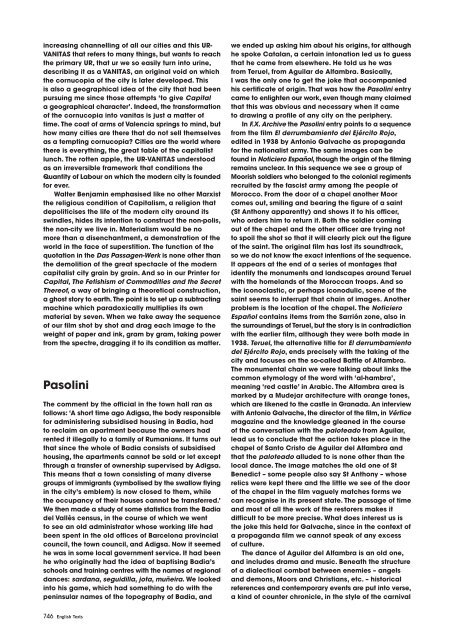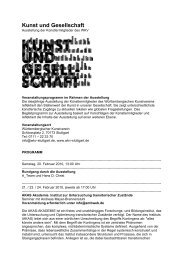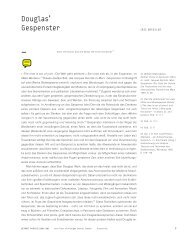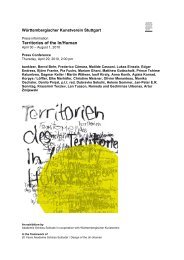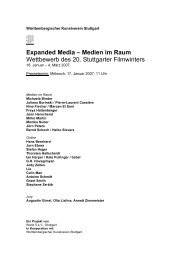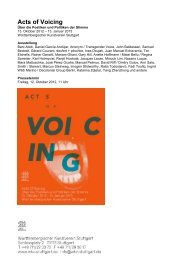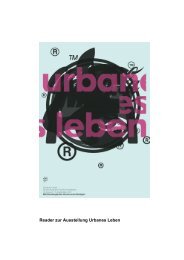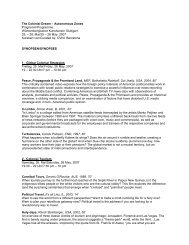English Texts
English Texts
English Texts
You also want an ePaper? Increase the reach of your titles
YUMPU automatically turns print PDFs into web optimized ePapers that Google loves.
increasing channelling of all our cities and this UR-<br />
VANITAS that refers to many things, but wants to reach<br />
the primary UR, that ur we so easily turn into urine,<br />
describing it as a VANITAS, an original void on which<br />
the cornucopia of the city is later developed. This<br />
is also a geographical idea of the city that had been<br />
pursuing me since those attempts ‘to give Capital<br />
a geographical character’. Indeed, the transformation<br />
of the cornucopia into vanitas is just a matter of<br />
time. The coat of arms of Valencia springs to mind, but<br />
how many cities are there that do not sell themselves<br />
as a tempting cornucopia? Cities are the world where<br />
there is everything, the great table of the capitalist<br />
lunch. The rotten apple, the UR-VANITAS understood<br />
as an irreversible framework that conditions the<br />
Quantity of Labour on which the modern city is founded<br />
for ever.<br />
Walter Benjamin emphasised like no other Marxist<br />
the religious condition of Capitalism, a religion that<br />
depoliticises the life of the modern city around its<br />
swindles, hides its intention to construct the non-polis,<br />
the non-city we live in. Materialism would be no<br />
more than a disenchantment, a demonstration of the<br />
world in the face of superstition. The function of the<br />
quotation in the Das Passagen-Werk is none other than<br />
the demolition of the great spectacle of the modern<br />
capitalist city grain by grain. And so in our Printer for<br />
Capital, The Fetishism of Commodities and the Secret<br />
Thereof, a way of bringing a theoretical construction,<br />
a ghost story to earth. The point is to set up a subtracting<br />
machine which paradoxically multiplies its own<br />
material by seven. When we take away the sequence<br />
of our film shot by shot and drag each image to the<br />
weight of paper and ink, gram by gram, taking power<br />
from the spectre, dragging it to its condition as matter.<br />
Pasolini<br />
The comment by the official in the town hall ran as<br />
follows: ‘A short time ago Adigsa, the body responsible<br />
for administering subsidised housing in Badia, had<br />
to reclaim an apartment because the owners had<br />
rented it illegally to a family of Rumanians. It turns out<br />
that since the whole of Badia consists of subsidised<br />
housing, the apartments cannot be sold or let except<br />
through a transfer of ownership supervised by Adigsa.<br />
This means that a town consisting of many diverse<br />
groups of immigrants (symbolised by the swallow flying<br />
in the city’s emblem) is now closed to them, while<br />
the occupancy of their houses cannot be transferred.’<br />
We then made a study of some statistics from the Badia<br />
del Vallès census, in the course of which we went<br />
to see an old administrator whose working life had<br />
been spent in the old offices of Barcelona provincial<br />
council, the town council, and Adigsa. Now it seemed<br />
he was in some local government service. It had been<br />
he who originally had the idea of baptising Badia’s<br />
schools and training centres with the names of regional<br />
dances: sardana, seguidilla, jota, muñeira. We looked<br />
into his game, which had something to do with the<br />
peninsular names of the topography of Badia, and<br />
we ended up asking him about his origins, for although<br />
he spoke Catalan, a certain intonation led us to guess<br />
that he came from elsewhere. He told us he was<br />
from Teruel, from Aguilar de Alfambra. Basically,<br />
I was the only one to get the joke that accompanied<br />
his certificate of origin. That was how the Pasolini entry<br />
came to enlighten our work, even though many claimed<br />
that this was obvious and necessary when it came<br />
to drawing a profile of any city on the periphery.<br />
In F.X. Archive the Pasolini entry points to a sequence<br />
from the film El derrumbamiento del Ejército Rojo,<br />
edited in 1938 by Antonio Galvache as propaganda<br />
for the nationalist army. The same images can be<br />
found in Noticiero Español, though the origin of the filming<br />
remains unclear. In this sequence we see a group of<br />
Moorish soldiers who belonged to the colonial regiments<br />
recruited by the fascist army among the people of<br />
Morocco. From the door of a chapel another Moor<br />
comes out, smiling and bearing the figure of a saint<br />
(St Anthony apparently) and shows it to his officer,<br />
who orders him to return it. Both the soldier coming<br />
out of the chapel and the other officer are trying not<br />
to spoil the shot so that it will clearly pick out the figure<br />
of the saint. The original film has lost its soundtrack,<br />
so we do not know the exact intentions of the sequence.<br />
It appears at the end of a series of montages that<br />
identify the monuments and landscapes around Teruel<br />
with the homelands of the Moroccan troops. And so<br />
the iconoclastic, or perhaps iconodulic, scene of the<br />
saint seems to interrupt that chain of images. Another<br />
problem is the location of the chapel. The Noticiero<br />
Español contains items from the Sarrión zone, also in<br />
the surroundings of Teruel, but the story is in contradiction<br />
with the earlier film, although they were both made in<br />
1938. Teruel, the alternative title for El derrumbamiento<br />
del Ejército Rojo, ends precisely with the taking of the<br />
city and focuses on the so-called Battle of Alfambra.<br />
The monumental chain we were talking about links the<br />
common etymology of the word with ‘al-hambra’,<br />
meaning ‘red castle’ in Arabic. The Alfambra area is<br />
marked by a Mudejar architecture with orange tones,<br />
which are likened to the castle in Granada. An interview<br />
with Antonio Galvache, the director of the film, in Vértice<br />
magazine and the knowledge gleaned in the course<br />
of the conversation with the paloteado from Aguilar,<br />
lead us to conclude that the action takes place in the<br />
chapel of Santo Cristo de Aguilar del Alfambra and<br />
that the paloteado alluded to is none other than the<br />
local dance. The image matches the old one of St<br />
Benedict – some people also say St Anthony – whose<br />
relics were kept there and the little we see of the door<br />
of the chapel in the film vaguely matches forms we<br />
can recognise in its present state. The passage of time<br />
and most of all the work of the restorers makes it<br />
difficult to be more precise. What does interest us is<br />
the joke this held for Galvache, since in the context of<br />
a propaganda film we cannot speak of any excess<br />
of culture.<br />
The dance of Aguilar del Alfambra is an old one,<br />
and includes drama and music. Beneath the structure<br />
of a dialectical combat between enemies – angels<br />
and demons, Moors and Christians, etc. – historical<br />
references and contemporary events are put into verse,<br />
a kind of counter chronicle, in the style of the carnival<br />
746 <strong>English</strong> <strong>Texts</strong>


